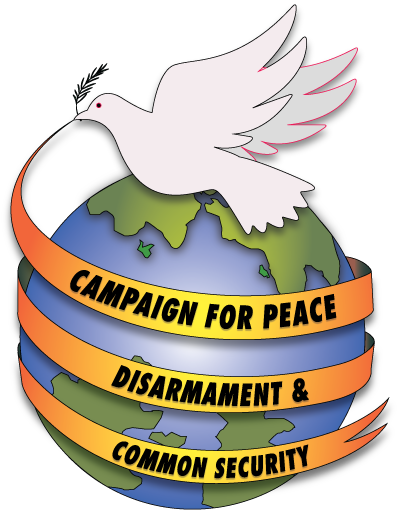November 29, 2023, Scandinavia House New York City
Remarks by Jackie Cabasso, Executive Director, Western States Legal Foundation
Looking around today’s world, we see a growing crowd of nationalist authoritarian governments and leaders – including in nuclear-armed Russia, Israel, India, China, North Korea and increasingly, the United States. In the other nuclear-armed states, Pakistan, the UK, and France, we see powerful nationalist authoritarian factions waiting in the wings.
The unprecedented fog of war and propaganda surrounding the Israeli war on Hamas and the Russian war on Ukraine, the afore-mentioned rising authoritarian nationalisms, and the conflation of national economic interests with “national security” compound the challenges of understanding the complexities of relationships among nuclear-armed states.
The Latin root of the word deterrence means to “frighten away, fill with fear.”[1] In other words, to threaten.
“Deterrence” undergirds entire military-industrial establishments and the national security states and elites they serve. It is an ideology which has outlived its Cold War origins and is used by nuclear-armed states to justify the perpetual possession and threatened use – including first use – of nuclear weapons.
In the U.S., national security policy has been remarkably consistent in the post-World War II and post-Cold War eras. “Nuclear Deterrence” – the threatened use of nuclear weapons –
has been reaffirmed as the “cornerstone” of U.S. national security by everyPresident, Republican or Democrat, since 1945, when President Harry Truman, a Democrat, oversaw the atomic bombings of Hiroshima and Nagasaki. Unfortunately, Russia and other would-be superpowers have increasingly modeled their own national security policies (as well as their economies) on the U.S. model.
What does nuclear deterrence mean? As described in a 2008 U.S. Department of Defense Report:
“Nuclear deterrence is achieved by credibly threatening a potential adversary with the use of nuclear weapons so as to prevent that adversary from taking actions against the United States, its allies, or its vital interests. This is accomplished primarily by maintaining sufficient and effective nuclear capabilities to pose unacceptable costs and risks upon the adversary should it so act.…”
“Though our consistent goal has been to avoid actual weapons use, the nuclear deterrent is ‘used’ every day by assuring friends and allies, dissuading opponents from seeking peer capabilities to the United States, deterring attacks on the United States and its allies from potential adversaries, and providing the potential to defeat adversaries if deterrence fails.”[2]
In a 2021 article titled, “Forging 21st-Century Strategic Deterrence,” U.S. Navy Admiral Charles Richard, then-Chief of U.S. Strategic Command, wrote:
“We must acknowledge the foundational nature of our nation’s strategic nuclear forces, as they create the ‘maneuver space’ for us to project conventional military power strategically.”[3]
With Russian and Israeli leadership’s veiled and not-so-veiled nuclear threats, Russia and Israel have both been using their nuclear deterrents in this way – so far. But it is undeniable that the longer these wars go on, the greater the threats of wider regional conflict and the potential for nuclear escalation become.
Over half the world’s population lives in countries whose national security postures explicitly depend on nuclear weapons and the doctrine of nuclear deterrence.”[4] In my view, “nuclear deterrence” is the Gordian knot blocking the path to nuclear disarmament.
All of the nuclear-armed states are engaged in costly programs to qualitatively and in some cases quantitatively expand their nuclear arsenals. A new nuclear arms race is underway – compounded by offensive cyber capabilities, Artificial Intelligence, developing hypersonic capacities, a return to intermediate-range delivery systems, and the production of delivery systems capable of carrying either conventional or nuclear payloads – thus blurring the distinction between nuclear and conventional weapons.
The speed and complexity of the interactions of all these technologies and the immense volumes of data involved increase the danger of miscalculation in a crisis, amid a global context that is generating crises involving nuclear-armed countries at an accelerating pace.
The United States is already planning to spend up to $1.5 trillion over 30 years to overhaul its nuclear arsenal. Plans include a new class of ballistic missile submarines, a new set of silo-based intercontinental ballistic missiles, a new nuclear cruise missile, a modified gravity bomb, a new stealthy long-range strike bomber, and accompanying warheads for each delivery system.[5]
However, some elements in the U.S. government don’t think this is enough. Just last month, the Congressional Commission on the U.S. Strategic Posture issued its report,[6] calling for reinforcing and building up U.S. nuclear forces based on the alarmist view that the U.S. could face simultaneous attacks by two peer nuclear adversaries, Russia, and China. According to the Commission, it can no longer be assumed “that nuclear forces necessary to deter or counter the Russian nuclear threat will be sufficient to deter or counter the Chinese nuclear threat simultaneously. Nuclear force sizing and composition must account for the possibility of combined aggression from Russia and China.”[7]
The Commission recommends enhancing the U.S. nuclear arsenal by expanding and accelerating the current modernization process, developing the capacity to produce additional nuclear warheads, developing “theater-range” nuclear weapons to provide increased “flexibility,” increasing the planned number of B-21 stealth bombers, Ohio-class nuclear ballistic missile submarines and long range standoff stealth nuclear cruise missiles, preparing to place multiple warheads on land-based ICBMs, and considering the development of road-mobile land-based missiles.[8] The Commission also recommends development and fielding of air and missile defense capabilities that can defeat Russian and Chinese attacks.[9]
It is worth noting that nine of the twelve members of the Commission have direct financial ties to military contractors or are employed at think tanks funded in part by weapons manufacturers.[10]
The recent meeting between Chinese President Xi and U.S. President Biden in San Francisco offered a glimmer of hope that the world’s two largest economies can peacefully manage their competition. But just this past Sunday, it was reported that China’s military had driven the guided-missile destroyer USS Hopper from China’s territorial waters, claiming the vessel had entered illegally. China’s state-run People’s Daily quoted a spokesman for the People’s Liberation Army as labeling the U.S. action a “serious violation” of China’s sovereignty and security. He described the United States as a “security risk maker in the South China Sea” and the “biggest destroyer” of peace and stability in the region. He said Chinese troops in the region would remain on high alert.
According to the U.S. Navy, the Hopper had “asserted navigational rights in the South China Sea, consistent with international law.” Adding to the friction with China, U.S. forces last week began air and sea patrols with the Philippines. Australia, another U.S. ally, recently sent a warship through the tense Taiwan Strait, between the mainland and Taiwan, which China claims as part of its territory despite opposition on the self-ruled island.[11]
The nuclear modernization programs underway in the United States, Russia, China, France, and the UK clearly violate their disarmament obligations under the Nuclear Nonproliferation Treaty (NPT) and international law in general. The hard truth is that neither the NPT nor the TPNW can achieve disarmament for the foreseeable future because none of the nuclear-armed states are willing to reimagine a global system that puts universal human security above the narrow interests of “national security” enforced by nuclear coercion – euphemistically called deterrence.
In 1946, Lewis Mumford wrote, “You cannot talk like sane men around a peace table while the atomic bomb itself is ticking beneath it. Do not treat the atomic bomb as a weapon of offense; do not treat it as an instrument of the police. Treat the bomb for what it is: the visible insanity of a civilization that has ceased to worship life and obey the laws of life.”[12]
At the thirty-sixth Annual Dinner of the War Resisters League in 1959, Dr. Martin Luther King, Jr. declared: “Today the choice is no longer between violence and nonviolence. It is either nonviolence or nonexistence.”[13]
And in 1971, at the height of the Vietnam War, John Lennon gave us the vision that shows the way forward:
“Imagine there’s no countries
It isn’t hard to do
Nothing to kill or die for
And no religion, too
Imagine all the people
Living life in peace
You may say I’m a dreamer
But I’m not the only one
I hope someday you’ll join us
And the world will be as one”[14]
Jackie Cabasso has been involved in nuclear disarmament, peace, and environmental advocacy locally, nationally, and internationally for more than four decades. She has served as Executive Director of Western States Legal Foundation, a nuclear disarmament advocacy organization in Oakland, California, since 1984, and was a “founding mother” of the Abolition 2000 Global Network to Eliminate Nuclear Weapons in 1995. Since 2007, she has served as North American Coordinator for Mayors for Peace. She also serves as National Co-convener for United for Peace and Justice. She received the International Peace Bureau’s 2008 Sean MacBride Peace Award, and the Agape Foundation’s 2009 Enduring Visionary Prize.
Notes
[1] deterrence | Etymology, origin and meaning of deterrence by etymonline
[2] Report of the Secretary of Defense Task Force on DoD Nuclear Weapons Management, Phase I: The Air Force’s Nuclear Mission, September 2008, p. 1, http://www.globalsecurity.org/jhtml/jframe.html#http://www.globalsecurity.org/wmd/library/report/2008/nuclearweapons_phase-1_2008-09-10.pdf
[3] Forging 21st-Century Strategic Deterrence | Proceedings – February 2021 Vol. 147/2/1,416 (usni.org)
[4] Why Mideast Nuclear-Weapon-Free Zone is Critical (pressenza.com)
[5] U.S.-Nuclear-Weapons-Modernization-Costs-Constraints-Fact-Sheet-v-May-2023.pdf (armscontrolcenter.org)
[6] ida.org/research-and-publications/publications/all/a/am/americas-strategic-posture
[7] strategic-posture-commission-report.ashx (ida.org)
[8] Strategic Posture Commission Report Calls for Broad Nuclear Buildup (fas.org)
[9] strategic-posture-commission-report.ashx (ida.org), p.72
[10] US nuke panel packed with weapons industry interests – Responsible Statecraft
[11] China Confronts U.S. Warship as Tension Grows Over Flashpoint: “Drove it Away” (newsweek.com)
[12] Lewis Mumford, “Gentlemen: You Are Mad!” The Saturday Review of Literature, 2 March 1946, collected in Bird and Lifschultz Citation1998, 284, 286
[13] Address at the Thirty-sixth Annual Dinner of the War Resisters League | The Martin Luther King, Jr. Research and Education Institute (stanford.edu)

